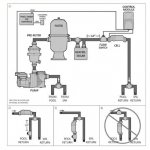- May 15, 2023
- 3
- Pool Size
- 13000
- Surface
- Vinyl
- Chlorine
- Salt Water Generator
- SWG Type
- Hayward Turbo Cell (T-CELL-5)
Looking for advice for new SWG for 24’ above ground. (~14,000 Gallons). Initially attracted to Hayward AquaTrol (W3AQ-TROL-RJ-TL), but have a few questions/concerns:
1. As the RJ model mounts directly up to the return jet, what is the consequence of having a split outlet prior to this to feed a second jet or water feature? Halving the flow, but would there still be sufficient flow running single speed 1HP pump? Would it require running pump longer to achieve desired levels?
2. Control cable is only 15’, but equipment is 20’ away. I could cut and splice an extension, but this likely voids the warranty.
3. I’ve considered the non-RJ model, but was looking to avoid cost, complexity and potential issues introduced with a flow sensor. Is this still a better way to go though to solve #1 and #2?
Thanks,
Darby
14K gal, AG vinyl, 1HP Splapool pump (or upgraded VS), 17” Jacuzzi 25 gpm sand filter, TBD SWG
1. As the RJ model mounts directly up to the return jet, what is the consequence of having a split outlet prior to this to feed a second jet or water feature? Halving the flow, but would there still be sufficient flow running single speed 1HP pump? Would it require running pump longer to achieve desired levels?
2. Control cable is only 15’, but equipment is 20’ away. I could cut and splice an extension, but this likely voids the warranty.
3. I’ve considered the non-RJ model, but was looking to avoid cost, complexity and potential issues introduced with a flow sensor. Is this still a better way to go though to solve #1 and #2?
Thanks,
Darby
14K gal, AG vinyl, 1HP Splapool pump (or upgraded VS), 17” Jacuzzi 25 gpm sand filter, TBD SWG
Last edited:


 Here's an illustration from the RJ-Series manual if it helps.
Here's an illustration from the RJ-Series manual if it helps.